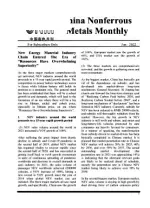China will Strictly Control Increase of Aluminum Capacity
China will Strictly Control Increase of Aluminum Capacity
"In 2017, the nonferrous metals industry performed well in growth rate, structure and benefits." Chen Quanxun, President of the China Nonferrous Metals Industry Association (CNMIA), said at the recently-held eighth meeting of the third Council of the CNMIA, "Last year, the production of ten kinds of nonferrous metals in China reached 55.01 million tons, up by 2.9% year-on-year, and the nonferrous metals industrial enterprises above the designated size (excluding independent gold enterprises) generated a profit of RMB 229.8 billion, up by 33.2% year-on-year."
The growth of industry profits in 2017 was mainly attributed to price rebounds. Data show that in 2017, the average price of major metals - copper, aluminum, lead and zinc increased by 29%, 16%, 26% and 43% year-on-year respectively in the domestic market. As a pillar of the new energy industry, cobalt rose more vigorously in price by 97%. The price rising trend of tungsten, molybdenum, tin, antimony and rare earth was also apparent. In the good market environment, the performance of enterprises has been continuously improved. According to statistics, the main business revenue of 8,324 nonferrous metals industrial enterprises above the designated size (excluding independent gold enterprises) amounted to RMB 5.6 trillion, up by 16.1% year-on-year. The asset liability ratio of the whole industry was 62.3%, down by 1.4 percentage points year-on-year. Chen said, "In recent years, nonferrous metals industrial enterprises have made significant progress in cost reduction and efficiency improvement. Some enterprises improved their rankings from the bottom 30% to the top 40% by comprehensive costs of leading products and some enterprises reduced their comprehensive costs by nearly 30% in a short period."
Meanwhile, the nonferrous metals industry has made considerable progress in terms of technology and green development, and its structure has been continuously optimized. The aircraft boards, automobile boards, nano ceramic aluminum, electrolytic copper foil and the new material cobalt lithium have made important contributions to the development of national defense and military industries and emerging industries. The comprehensive power consumption of aluminum, the comprehensive energy consumption of copper, lead and zinc smelting and the emissions are further reduced. The investment in processing projects has shown restorative growth, reversing the downward trend that has lasted two years.
Jia Mingxing, a spokesman for the CNMIA, said that the aluminum industry has constantly adjusted and optimized structure in the past two years, forcing non-competitive capacity to exit according to the law, and has closed down illegal production capacity of more than 5 million tons. Worth noting is that the situation of declining investment in the nonferrous metals industry didn't change in 2017.
"At present, due to resources and environmental constraints, the pressures of oversupply and rising cost, and the weaknesses in technological innovation and application, it's difficult to fundamentally improve the industry in the short term." Chen Quanxun said that some of the major economies represented by the United States are taking trade protection measures, including prices and taxes to restrict foreign product imports and are strengthening security reviews to restrict foreign investment, and that the consequent economic and trade frictions may strike a blow on the recovery of global trade and investment.
"China's nonferrous metals industry has a complete system. China is indeed an industrial power with a huge market, rich human resources and obvious comprehensive advantages. The industry is fully capable of achieving higher quality, more efficient and more sustainable development." Chen said, "Next, we should focus on the supply-side structural reform. In particular, we should strictly control increase of aluminum capacity, vigorously eliminate low-end inefficient capacity, and continue to adjust and optimize the industrial structure. In the meantime, as the industry's average asset liability ratio is 62.3%, much higher than the national industrial average, the market price fluctuates frequently and the investment risk becomes prominent, we should pay prominent attention to risk prevention and control."
 China Nonferrous Metals Monthly2018年5期
China Nonferrous Metals Monthly2018年5期
- China Nonferrous Metals Monthly的其它文章
- Jinfei Kaida Invested in The Construction of Lightweight Aluminum Alloy Auto Rim Project
- PikeResearch: New Energy Greatly Promotes China's Rare Earth Industry
- Remarkable Performance in Lithium Battery Copper Foil Market
- Nonferrous Geological Prospecting Institutions Discover Important Mineral and Rare Metal Reserves
- Zhejiang Cuts Aluminum Capacity By 150,000 Tons In 2017
- Zinc Production by Province in 2017
